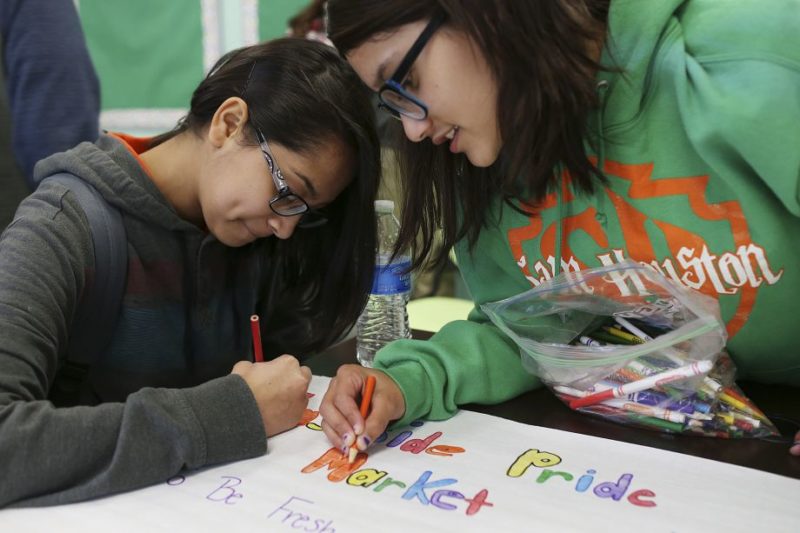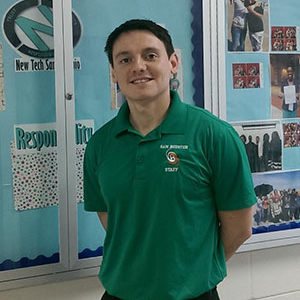
Share On Social!
From PowerPoint presentations to outlines to thick textbooks, there are many ways students learn about the world while at school. Rarely do they get the chance to learn by actually solving real-world problems—let alone problems that directly affect their lives. Learn how a high school teacher merged academics with activism and rallied his students to bring healthy, affordable fruits and vegetables into their underserved neighborhood.
EMERGENCE
Awareness: While listening to the radio one day, San Antonio resident and high school teacher Rick Treviño got an idea.
He was listening to a news story about how a group in Michigan started a Double Up Food Bucks program at local farmers’ market as a way to allow low-income folks to put their federal food assistance toward healthy fruits and vegetables. Double Up provides SNAP recipients with a one-to-one match to purchase healthy fruits and vegetables when they use their assistance card at participating farmers’ markets.
“So if I spend $20, the market will also give me $20 for a total of $40,” Treviño said.
None of the farmers’ markets in San Antonio have a Double Up program.
“I thought it’d be great to have that type of market in San Antonio,” he said.
He had a feeling he could help bring affordable, healthy food into his community all while giving his students a hands-on lesson in urban food access.
Learn: Treviño teaches social studies at Sam Houston High School on San Antonio’s Eastside, where the majority of students are Hispanic. The Eastside neighborhood has struggled with poverty, violence and health issues for years.
For many of Treviño’s students, buying dinner from a corner store or taking hour-long bus trips just to access healthy food is a daily reality.
Frame Issue: Treviño’s world geography class studies urban geography, including food access and food deserts, but this year he decided to ditch the PowerPoint slides and involve his students in the urban geography happening in their own backyard.
He decided he and his class would bring a farmers’ market to Sam Houston.
Treviño said his new project would not only teach students about food insecurity, but would also be a sustainable solution to a real-life problem his students are actually living.
“Why don’t we use this farmers’ market to alleviate some of the pressure food deserts create?” he said.
Treviño said his students were used to working on a project that had a start and finish. Once the poster was taken down or the presentation given, that was the end. But not with this project.
“This was new for them,” he said. “They were actually going to be a part of a community project.”
He said the kids were somewhat excited when he told them about the year-long project.
“But they had no idea they were going to be a part of something so impactful.”
DEVELOPMENT
Education: Treviño first ran his market idea by his school’s principal, who gave his full support.
Sam Houston is one of five campuses at the epicenter of a federal Promise Neighborhood grant, which aims to fight poverty in the area with $24.6 million for early education initiatives, school reforms and health and wellness programs, among other initiatives.
Treviño then took the idea to the Eastside Promise Neighborhood with the market idea, which supports a handful of community initiatives. He said they were supportive and had already been thinking about starting a market in the area.
Treviño laid-out the benefits of having the market at the high school.
“If we have it at Sam Houston, we can also connect lessons to it,” he said.

The Eastside Promise Neighborhood encouraged Treviño and his students to plan out the market.
Mobilization: On Jan. 18, 2015, a small delegation of students presented the farmers’ market proposal to the Promise and Choice Neighborhood grant officials at the Ella Austin Community Center.
The officials decided to award grant funds to the San Antonio Food Bank (Food Bank), which runs six markets around San Antonio, to work with Treviño and his students to set up a Food Bank farmers’ market at Sam Houston.
Back at the school, other classes began getting involved. Students in audio and visual technology class teamed-up with Treviño’s class to create print and radio advertisements for the market.
Treviño and students called newspapers and news stations to make promotional connections, and got coverage from the San Antonio Express-News, The University of Texas at San Antonio, and others.
“The more public it is, the more likely it’s going to be successful,” Treviño said.
“You’re kind of sneaking-in learning with a cool project like this,” he said.
Debate: Even with the generous support of the Eastside Promise Neighborhood and the Food Bank, Treviño still didn’t have enough funds to implement the Double Up program like he had initially hoped.
So, he had to learn how to write grants.
“That was a new thing for me,” he said
It appeared that even if he could secure the funds, the Double Up program wouldn’t be up and running by the first market, planned for late April 2015. Yet, Treviño and the students had already come a long way and weren’t going to let a small setback ruin their plans.
“It takes a lot of effort, you have to be tenacious,” Treviño said.
ENACTMENT
Activation: As market operators, the Food Bank would be in charge of market logistics, like securing vendors and operating the point-of-sales systems. This was crucial, Treviño said, because he could only do so much.
While plans for the market were moving forward, Treviño and his students began working on another piece of their food insecurity project: transportation access.
Treviño envisioned a bike program where students would take fresh fruits and vegetables to Eastside residents who didn’t have the transportation means to make it to the farmers’ market.
“As long as we have a Farmers’ Market at Sam Houston, we want to give those families in the community without vehicle access an opportunity to network with our market,” he said.
Frame policy: The students truly were a part of the effort, said Treviño.
They mapped out a location on campus, proposed community partnerships, brainstormed marketing campaigns and worked out other logistics.
Hoping to get the bike program rolling, Treviño met with the founder of the West Side cooperative Earn-A-Bike, Cristian Sandoval. Earn-A-Bike helps kids learn mechanical skills by building new bicycles or fixing up donated old ones and emphasizes improving one’s community through giving back.
Sandoval was willing to give the group five donated bikes. He committed to teach students how to repair the bikes, outfit them with helmets and show them how to ride safely on the East Side, which has few bike lanes. According to the Express-News article, Sandoval also told Treviño to track how much produce they were delivering through the program, a good business practice, he said.
Change: The first Sam Houston Farmers’ Market was opened on April 18, 2015.
While Treviño said they are still trying to get the word out, the fact that the market was officially launched was a big deal to him and his students.
“What’s beautiful about this program is that the kids did it,” Treviño said. “It made me love my profession more, to see that we can actually empower kids to change the community.”
IMPLEMENTATION
Implementation: The market will run from April through September 2015.
In May, they plan to launch the bike food delivery program.
“Hopefully through that we can offer some kids some job opportunities,” Treviño said.
Equity: As for the dream that started it all, the Double Up program, Treviño hopes to have the funds to finance it by June 2015.
“The Food Bank is working with the Fair Foods Network to launch the program this summer,” he said. The Fair Foods Network is the non-profit that started the program in Michigan.
In the meantime, the market does accept SNAP benefits, allowing everyone, regardless of income, to shop at the market. And hopefully soon, SNAP dollars will get doubled.
Sustainability: Treviño is confident that the Sam Houston Farmers’ Market will continue to grow and serve the community better with each market day.
He has observed a change in his students, who are paying more attention to issues in their neighborhood.
“Now they come in and say, ‘Hey I saw someone at the bus stop with grocery bags or I was at [the grocery store] and there was a lady waiting for a car because she doesn’t have transportation access,’” he said.
He hopes he’s given them the tools to begin to notice these issues and to take action.
For Treviño, the journey is never-ending. He’s hoping that the bike project will start conversations about bike safety on the East Side.
“We might propose biking lanes for the community,” he said.
Despite his successes and the impact he is having on his students, Treviño is humble yet confident in his ability to create positive change.
“I don’t know how I did it really; I just kept trying,” he said.
This success story was produced by Salud America! with support from the Robert Wood Johnson Foundation.
The stories are intended for educational and informative purposes. References to specific policymakers, individuals, schools, policies, or companies have been included solely to advance these purposes and do not constitute an endorsement, sponsorship, or recommendation. Stories are based on and told by real community members and are the opinions and views of the individuals whose stories are told. Organization and activities described were not supported by Salud America! or the Robert Wood Johnson Foundation and do not necessarily represent the views of Salud America! or the Robert Wood Johnson Foundation.
ABOUT THE PROGRAM
Salud America! The RWJF Research Network to Prevent Obesity Among Latino Children is a national program of the Robert Wood Johnson Foundation. The program aims to educate researchers, decision-makers, community leaders, and the public in contributing toward healthier Latino communities and seeking environmental and policy solutions to the epidemic of Latino childhood obesity. The network is directed by the Institute for Health Promotion Research at the University of Texas Health Science Center at San Antonio.
For more information, visit http://www.salud-america.org.
By The Numbers
1
Supermarket
for every Latino neighborhood, compared to 3 for every non-Latino neighborhood
This success story was produced by Salud America! with support from the Robert Wood Johnson Foundation.
The stories are intended for educational and informative purposes. References to specific policymakers, individuals, schools, policies, or companies have been included solely to advance these purposes and do not constitute an endorsement, sponsorship, or recommendation. Stories are based on and told by real community members and are the opinions and views of the individuals whose stories are told. Organization and activities described were not supported by Salud America! or the Robert Wood Johnson Foundation and do not necessarily represent the views of Salud America! or the Robert Wood Johnson Foundation.



